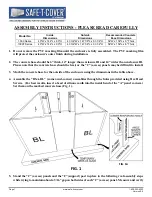
AM32 MULTIPLEXER
11
wire can be minimized by coiling some wire
inside the enclosure. This procedure allows the
heat to dissipate before it reaches the terminal.
Some consideration should be made as to what
type of thermocouple wire to use. Different
types and sizes of wires, or metals, have
different characteristics including thermal
conductivity.
7.0 PROGRAMMING EXAMPLES
7.1 CR10(X) PROGRAMMING EXAMPLE: 32
SOIL MOISTURE BLOCKS, MODEL 223
This example will use a CR10(X) datalogger to
measure Model 223 Soil Moisture blocks.
This program samples the 32 soil moisture
potentials every 6 hours (360 minutes).
The leads from the block electrodes are
connected directly to the AM32; the lead from
the center electrode attaches to high and the
lead from the outer electrode to low. It is
imperative that this wiring convention remains
consistent so that current flow is confined to the
interior of the block minimizing ground loops.
A 1k ohm resistor between the input and
excitation channel is used to complete the half
bridge as shown in Figure 7-1.
Instruction 5 (AC Half Bridge) is used to excite
and measure the 223. The output from
Instruction 5 is the ratio of signal voltage to
excitation voltage.
Following the measurement, the Bridge
Transform Instruction, P59, is used to calculate
the block resistances in kohms. To avoid
overranging, a multiplier of 1 is used to output
sensor resistance (RS) in terms of k ohms.
Soil water potential (in bars) is calculated from
RS using a fifth order polynomial (Instruction
55). Depending on the value of RS, one of two
polynomials is selected to convert RS to soil
water potential. If RS is greater than 17.009k
ohms, soil water potential is not calculated, the
value of RS is output.
FIGURE 7-1. Wiring Diagram for CR10(X),
AM32 and 223 Soil Moisture Block example.
Summary of Contents for AM32
Page 27: ...This is a blank page ...














































